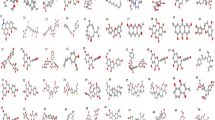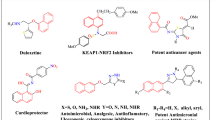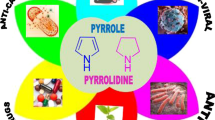Abstract
Phloroglucinol compounds isolated from Dryopteris fragrans (L.) Schott showed a variety of biological activities, such as anticancer and anti-inflammatory. In this study, we have made a number of modifications around the scaffold of phloroglucinol and synthesized phloroglucinol derivatives A1–A9, B1–B9, and C1–C3. We synthesized these compounds and investigated their effect on four human cancer cell lines (A-549, MCF-7, Hela, HepG2 cell lines) via MTT assay in vitro. The results revealed that all compounds exhibited certain antiproliferative activities on cancer cell lines and excellent inhibitory effects on MCF-7, in which compound C2 was the best with the IC50 value of 18.49 μM, exceeding that of 5-fluorouracil. Moreover, the cell apoptosis test showed that compound C2 induced apoptosis in a concentration-dependent manner. Furthermore, the results of molecular docking analysis explained the probable interaction between the active compounds and active sites of target protein 4I22 and 1OG5.






Similar content being viewed by others
References
Faisca Phillips AM. Recent developments in anti-cancer drug research. Curr Med Chem. 2019;26:7282–4.
Wang JJ, Lei KF, Han F. Tumor microenvironment: recent advances in various cancer treatments. Eur Rev Med Pharm Sci. 2018;22:3855–64.
Hanahan D. Rethinking the war on cancer. Lancet 2014;383:558–63.
Vasan N, Baselga J, Hyman DM. A view on drug resistance in cancer. Nature. 2019;575:299–309.
Zhong ZC, Zhao DD, Liu ZD, Jiang S, Zhang YL. A new human cancer cell proliferation inhibition sesquiterpene, dryofraterpene A, from medicinal plant Dryopteris fragrans (L.) Schott. Molecules. 2017;22:180
Zhang Y, Luo M, Zu Y, Fu Y, Gu C, Wang W, et al. Dryofragin, a phloroglucinol derivative, induces apoptosis in human breast cancer MCF-7 cells through ROS-mediated mitochondrial pathway. Chem Biol Interact. 2012;199:129–36.
Sun Y, Mu F, Li C, Wang W, Luo M, Fu Y, et al. Aspidin BB, a phloroglucinol derivative, induces cell cycle arrest and apoptosis in human ovarian HO-8910 cells. Chem Biol Interact. 2013;204:88–97.
Ye L, Lin P, Du W, Wang Y, Tang C, Shen Z. Preparation, antidermatophyte activity, and mechanism of methylphloroglucinol derivatives. Front Microbiol. 2018;9:2262.
Teng X, Wang Y, Gu J, Shi P, Shen Z, Ye L. Antifungal agents: design, synthesis, antifungal activity and molecular docking of phloroglucinol derivatives. Molecules. 2018;23:3116.
Yan P, Lai Q, Li M, Jin X, Wie G, Chen W, et al. New anticancer agents: design, synthesis, biological activity, and molecular docking of bicyclic phloroglucinol derivatives. ChemistrySelect. 2021;6:1453–7.
Liu Z, Zhao D, Jiang S, Xue B, Zhang Y, Yan X. Anticancer phenolics from Dryopteris fragrans (L.) Schott. Molecules. 2018;23:680.
Li N, Khan SI, Qiu S, Li XC. Synthesis and anti-inflammatory activities of phloroglucinol-based derivatives. Molecules. 2018;23:3232.
Henry GE, Campbell MS, Zelinsky AA, Liu Y, Bowen-Forbes CS, Li L, et al. Bioactive acylphloroglucinols from hypericum densiflorum. Phytother Res. 2009;23:1759–62.
Fleisher TA. Apoptosis. Ann Allergy Asthma Immunol. 1997;78:245–50.
Pagadala NS, Syed K, Tuszynski J. Software for molecular docking: a review. Biophys Rev. 2017;9:91–102.
Yang G, Yang Z. Applications of docking and molecular dynamics in drug design. Curr Comput Aided Drug Des. 2013;9:506.
Hsu JL, Hung MC. The role of HER2, EGFR, and other receptor tyrosine kinases in breast cancer. Cancer Metastasis Rev. 2016;35:575–88.
Nagini S. Breast cancer: current molecular therapeutic targets and new players. Anticancer Agents Med Chem. 2017;17:152–63.
Sayed M, Voronkov A, Ogungbe IV, El-Hallouty SM, Balakin K. Anti cancer, molecular docking and structure activity relationship studies of some novel synthetic spiroindolo[3,2-b]carbazoles as predicted HER2 and BrK kinase inhibitors. Curr Bioact Compd. 2018;14:119–33.
Manish M, Lynn AM, Mishra S. Cytochrome P450 2C9 polymorphism: effect of amino acid substitutions on protein flexibility in the presence of tamoxifen. Comput Biol Chem. 2020;84:107166.
Samowitz WS, Wolff RK, Curtin K, Sweeney C, Ma KN, Andersen K, et al. Interactions between CYP2C9 and UGT1A6 polymorphisms and nonsteroidal anti-inflammatory drugs in colorectal cancer prevention. Clin Gastroenterol Hepatol. 2006;4:894–901.
Gajiwala KS, Feng J, Ferre R, Ryan K, Brodsky O, Weinrich S, et al. Insights into the aberrant activity of mutant EGFR kinase domain and drug recognition. Structure. 2013;21:209–19.
Williams PA, Cosme J, Ward A, Angove HC, Vinković DM, Jhoti H. Crystal structure of human cytochrome P450 2C9 with bound warfarin. Nature 2003;424:464–8.
Acknowledgements
The work was supported by the Innovation and strengthening project of Guangdong Pharmaceutical University-Special Innovation including Project of Guangdong Education Department (2017KTSCX107, 2020KZDZX1131, 2020ZDZX3026, Guangdong Pharmaceutical University [2020]96), and “Guangdong Province Graduate Education Innovation Program in 2020 and 2021(2021JGXM071)”, Science and Technology Planning Project of Guangdong Province (2017ZC0199), Medical Scientific Research Foundation of Guangdong Province (B2019004), Special fund for economic and technological development of Longgang District (LGKCYLWS2020103).
Author information
Authors and Affiliations
Corresponding author
Ethics declarations
Conflict of interest
The authors declare no competing interests.
Ethical approval
This article does not contain any studies with human participants or animals performed by any of the authors.
Additional information
Publisher’s note Springer Nature remains neutral with regard to jurisdictional claims in published maps and institutional affiliations.
These authors contributed equally: Fuli Zhang, Qingfu Lai.
Supplementary information
Rights and permissions
About this article
Cite this article
Zhang, F., Lai, Q., Lai, W. et al. Phloroglucinol derivatives as anti-tumor agents: synthesis, biological activity evaluation and molecular docking studies. Med Chem Res 31, 165–176 (2022). https://doi.org/10.1007/s00044-021-02828-0
Received:
Accepted:
Published:
Issue Date:
DOI: https://doi.org/10.1007/s00044-021-02828-0




